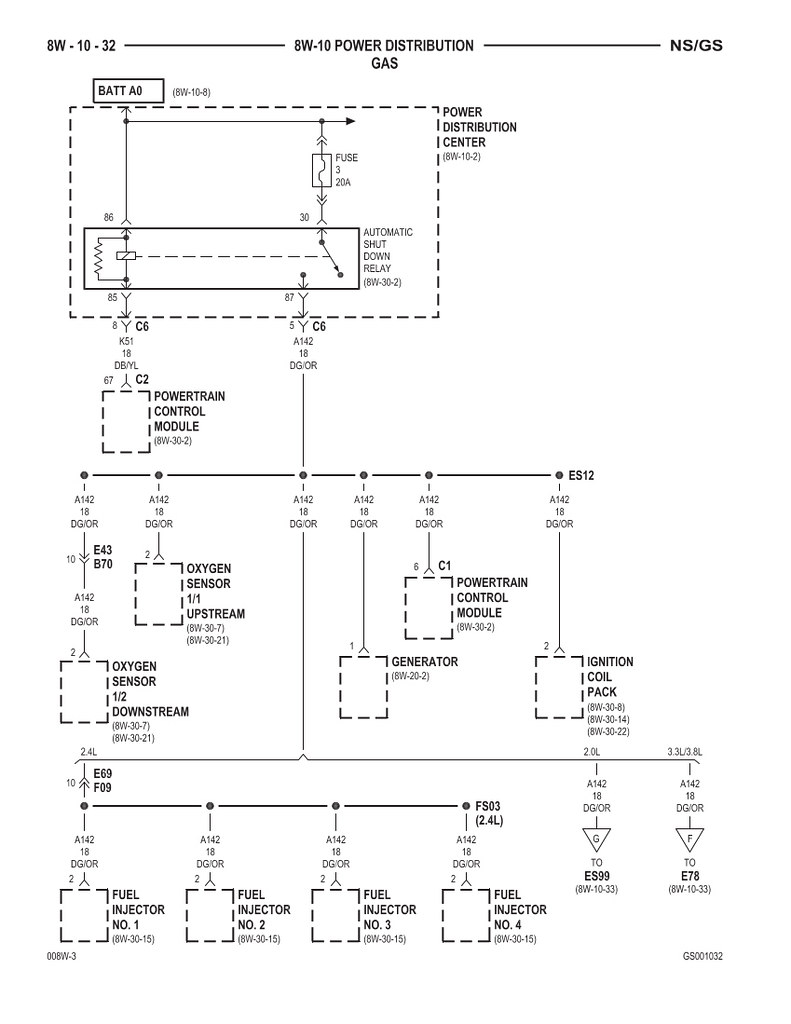AUTOMATIC SHUTDOWN (ASD) SENSE - PCM INPUT
It is an input to the Powertrain Control Module from the rely in the Power Distribution Center, refer to the cover for relay location.
The ASD sense circuit informs the PCM when the ASD relay energizes. A 12 volt signal at this input indicates to the PCM that the ASD has been activated. This input is used only to sense that the ASD relay is energized.
When energized, the ASD relay supplies battery voltage to the fuel injectors, ignition coils and the heating element in each oxygen sensor. If the PCM does not receive 12 volts from this input after grounding the ASD relay, it sets a Diagnostic Trouble Code (DTC) .
When energized, the ASD relay provides power to operate the injectors, ignition coil, generator field, O2 sensor heaters (both upstream and downstream), and also provides a sense circuit to the PCM for diagnostic purposes. The PCM energizes the ASD any time there is a Crankshaft Position sensor signal that exceeds a predetermined value. The ASD relay can also be energized after the engine has been turned off to perform an O2 sensor heater test, if vehicle is equipped with OBD II diagnostics.
With SBEC III, the ASD relay’s electromagnet is fed battery voltage, not ignition voltage. The PCM still provides the ground. As mentioned earlier, the PCM energizes the ASD relay during an O2 sensor heater test. This test is performed only after the engine has been shut OFF. The PCM still operates internally to perform several checks, including monitoring the O2 sensor heaters. This and other DTC tests are explained in detail in the On-Board Diagnostic Student Reference Book.
AUTOMATIC SHUTDOWN RELAY - PCM OUTPUT
Fig. 1 Powertrain Control Module (PCM)
The ASD relay and fuel pump relay are located in the Power Distribution Center (PDC) near the Air Cleaner. The inside top of the PDC cover has a label showing relay and fuse location. They are ISO relays.
The PCM operates the Automatic Shut Down (ASD) relay and fuel pump relay through one ground path. The PCM operates them by switching the ground path for the relays ON and OFF.
The ASD relay connects battery voltage to the fuel injectors and ignition coil. The fuel pump relay connects battery voltage to the fuel pump.
The PCM turns the ground path off when the ignition switch is in the OFF position, unless the O2 Heater Monitor test is being run. When the ignition switch is in the ON or CRANK position, the PCM monitors the Crankshaft Position Sensor and Camshaft Position Sensor signals to determine engine speed.
If the PCM does not receive a Crankshaft Position Sensor signal and Camshaft Position Sensor signal when the ignition switch is in the RUN position, it de-energizes both relays. When the relays are de-energized, battery voltage is not supplied to the fuel injectors, ignition coil and fuel pump.
